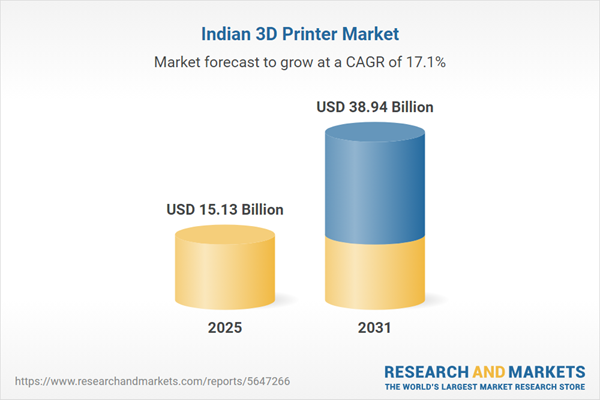Free Webex Call
The India 3D Printer Market was valued at USD 15.13 Billion in 2025, and is expected to reach USD 38.94 Billion by 2031, rising at a CAGR of 17.06%. This market encompasses the expanding adoption of 3D printing technologies and services across various industries in India. Also known as additive manufacturing, 3D printing involves creating objects layer by layer based on digital designs. Its adoption is gaining pace in sectors such as automotive, aerospace, healthcare, consumer electronics, and education, where customization, design precision, and rapid prototyping are becoming crucial. The technology's potential to reduce development time and enable agile innovation is making it an increasingly valuable tool in India’s evolving manufacturing ecosystem. Speak directly to the analyst to clarify any post sales queries you may have.
10% Free customizationThis report comes with 10% free customization, enabling you to add data that meets your specific business needs.
Key Market Drivers
Rapid Prototyping and Product Innovation
The growing emphasis on faster product development and cost-efficient prototyping is driving the adoption of 3D printing across India's industrial landscape. Engineering firms and startups are leveraging this technology to shorten design cycles and reduce reliance on outsourced prototyping services. This flexibility enables small manufacturers to compete more effectively by enabling iterative design and faster time-to-market. The transition from traditional methods such as CNC machining to in-house 3D printing allows for more precise geometry control and reduced material wastage. This shift is particularly impactful in sectors like consumer electronics, EV components, and industrial design. In Bengaluru’s Peenya Industrial Hub, over 300 MSMEs adopted in-house 3D printers between 2022 and 2024, achieving a 40% reduction in outsourcing costs and doubling their prototype turnaround time - resulting in quicker product launches and increased innovation output.Key Market Challenges
High Capital Costs and Limited Industrial Scale Accessibility
A significant obstacle to widespread 3D printing adoption in India is the high cost of acquiring industrial-grade printers, particularly those that work with metals and advanced composites. Beyond the cost of hardware, firms must invest in specialized software, maintenance, post-processing tools, and skilled technical staff. This makes 3D printing financially out of reach for many small and medium enterprises that operate on tight margins.Moreover, India lacks robust leasing or financing options for this technology, unlike conventional CNC machines, limiting scalability. High-end machines are often imported, subjecting buyers to additional expenses like customs duties, currency fluctuations, and logistical delays. The absence of a localized supply chain for advanced equipment and materials further complicates cost-efficiency. As a result, the technology remains confined to innovation-centric enterprises, research institutions, and select industrial clusters, rather than becoming a widespread manufacturing solution.
Key Market Trends
Shift Toward Localized Manufacturing and On-Demand Production
An important trend in India’s 3D printer market is the movement toward decentralized and localized manufacturing. Companies are turning to 3D printing to establish flexible production hubs closer to demand centers, reducing supply chain dependency and enabling faster production. This is particularly relevant for industries like healthcare, automotive spares, and consumer goods where speed, customization, and availability are vital.On-demand manufacturing is also gaining ground, allowing companies to produce components in small quantities without maintaining large inventories. This supports cost-efficiency and agility in responding to design modifications or shifting market demands. The trend aligns with India’s broader objectives of building self-reliant supply chains and reducing imports for essential components. As digital design files begin to replace physical inventories, the concept of distributed fabrication and digital warehousing is expected to gain broader adoption, reshaping traditional manufacturing models.
Key Market Players
- Imaginarium Pvt Ltd.
- Divide By Zero Technologies Pvt Ltd.
- Stratasys Ltd.
- Make3d.in
- Brahma3 Pvt Ltd.
- TDL Mould Co. Pvt Ltd.
- Altem Technologies Pvt Ltd.
- Think3D Pvt Ltd.
Report Scope:
In this report, the India 3D Printer Market has been segmented into the following categories, in addition to the industry trends which have also been detailed below:India 3D Printer Market, By Type:
- Personal Printer
- Industrial Printer
India 3D Printer Market, By Process:
- Powder Bed Fusion
- Vat Polymerization/ Liquid Based
- Material Extrusion
- Binder Jetting
- Material Jetting
- Others
India 3D Printer Market, By End User Industry:
- Automobile
- Consumer Electronics/Electronics
- Medical
- Aerospace
- Defence
- Education
- Others
India 3D Printer Market, By Region:
- South India
- North India
- West India
- East India
Competitive Landscape
Company Profiles: Detailed analysis of the major companies present in the India 3D Printer Market.Available Customizations:
With the given market data, the publisher offers customizations according to a company's specific needs. The following customization options are available for the report.Company Information
- Detailed analysis and profiling of additional market players (up to five).
This product will be delivered within 1-3 business days.
Table of Contents
1. Product Overview
2. Research Methodology
3. Executive Summary
5. India 3D Printer Market Outlook
6. South India 3D Printer Market Outlook
7. North India 3D Printer Market Outlook
8. West India 3D Printer Market Outlook
9. East India 3D Printer Market Outlook
10. Market Dynamics
11. Market Trends & Developments
14. Company Profiles
Companies Mentioned
- Imaginarium Pvt Ltd.
- Divide By Zero Technologies Pvt Ltd.
- Stratasys Ltd.
- Make3d.in
- Brahma3 Pvt Ltd.
- TDL Mould Co. Pvt Ltd.
- Altem Technologies Pvt Ltd.
- Think3D Pvt Ltd.
Table Information
| Report Attribute | Details |
|---|---|
| No. of Pages | 70 |
| Published | July 2025 |
| Forecast Period | 2025 - 2031 |
| Estimated Market Value ( USD | $ 15.13 Billion |
| Forecasted Market Value ( USD | $ 38.94 Billion |
| Compound Annual Growth Rate | 17.0% |
| Regions Covered | India |
| No. of Companies Mentioned | 8 |









